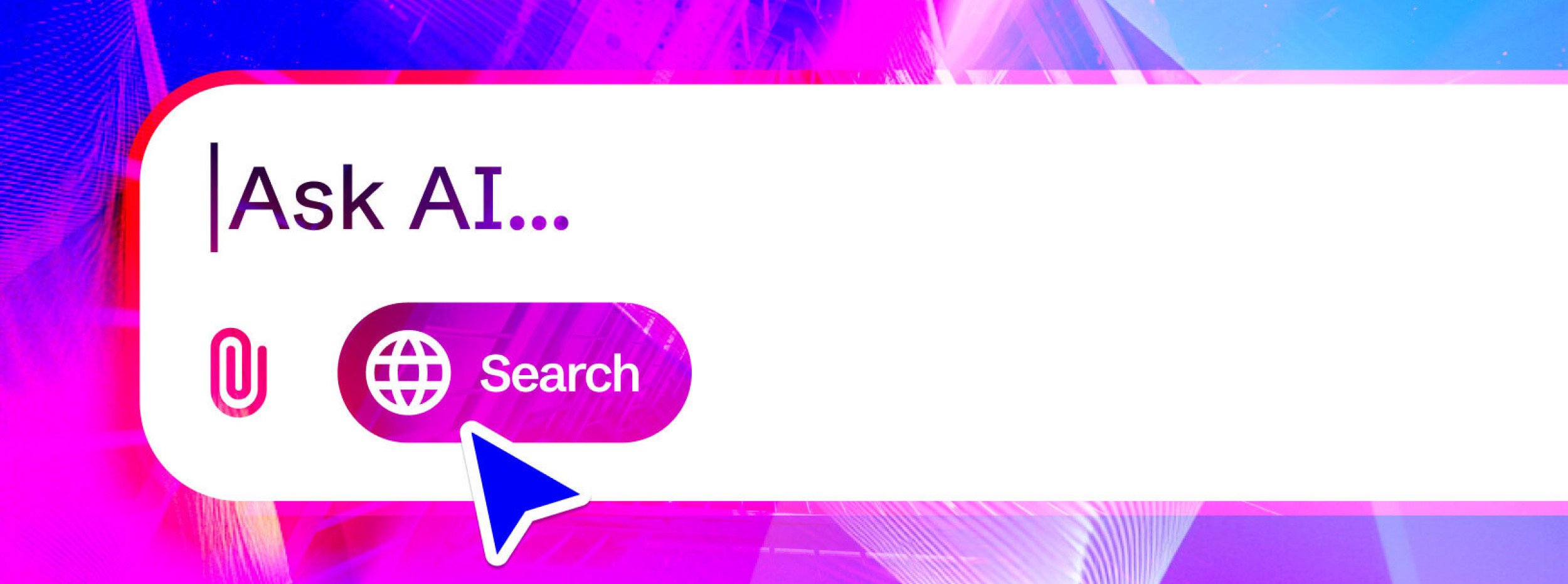Executive Summary
AI has become big news when it comes to how people search, discover, and interact with content online.
Even though Gartner has reported that up to 50% of search engine volume could be replaced by AI-driven platforms and virtual agents, the data and insights available provide clarity on reality rather than the hype of the headlines.
Businesses are having to consider the impact of AI and how to navigate it. This also opens up questions about commercial opportunities to drive revenue and bottom line.
This article outlines why it’s important to keep calm and take action to optimise for the future, using data insights to inform strategy and focus on user experiences.
Traditional SEO still dominates, but Generative Engine Optimisation (GEO) is emerging and Retrieval-Augmented Generation (RAG) offers a middleground for content strategy.
This paper outlines how AI is changing the interface of the web, what brands must do to stay relevant, and how to optimise across both traditional and generative engines.
It provides a solutions framework, strategic roadmap, 4-step process, and a quick stakeholder summary checklist to help CMOs, CTOs, COOs, and procurement leaders future-proof their marketing and content strategies for the future.
If you're short on time, here is the condensed version, cutting straight to the solutions frameworks, roadmap, and checklist.
Table of contents
Table of Contents
- Introduction
- Framing AI and the 3 different use cases
- The interface shift: from search to suggest
- The SEO vs GEO dilemma and opportunity
- What is RAG and why it matters
- Strategic roadmap: 7 actions to take now
- The 7DOTS solution: user-centric experience
- Next steps
- Stakeholder summary checklist for CMOs, CTOS/COOS and procurement.
- References
1. Introduction
With attention-grabbing headlines declaring that websites not optimised for Large Language Models (LLMs) risk becoming invisible to 50% of the search market, many businesses are asking the same thing:
Should we be worried about AI and SEO?
The digital ecosystem is evolving fast. AI agents are increasingly shaping how users find and consume information, in addition to traditional search engines. This impacts how brands are thinking about discovery, content ownership, and their digital experience.
Even though Gartner has reported that up to 50% of search engine volume could be replaced by AI-driven platforms and virtual agents, the data and insights available provide clarity on reality rather than the hype of the headlines.
While there has been a lot of noise about how Google's market share dipped below 90% for the first time in nearly a decade, with some sites reporting traffic drops of over 40%, Google have stated “We continue to see overall query growth in Search.” (May 25)
Image: Google Daily Searches
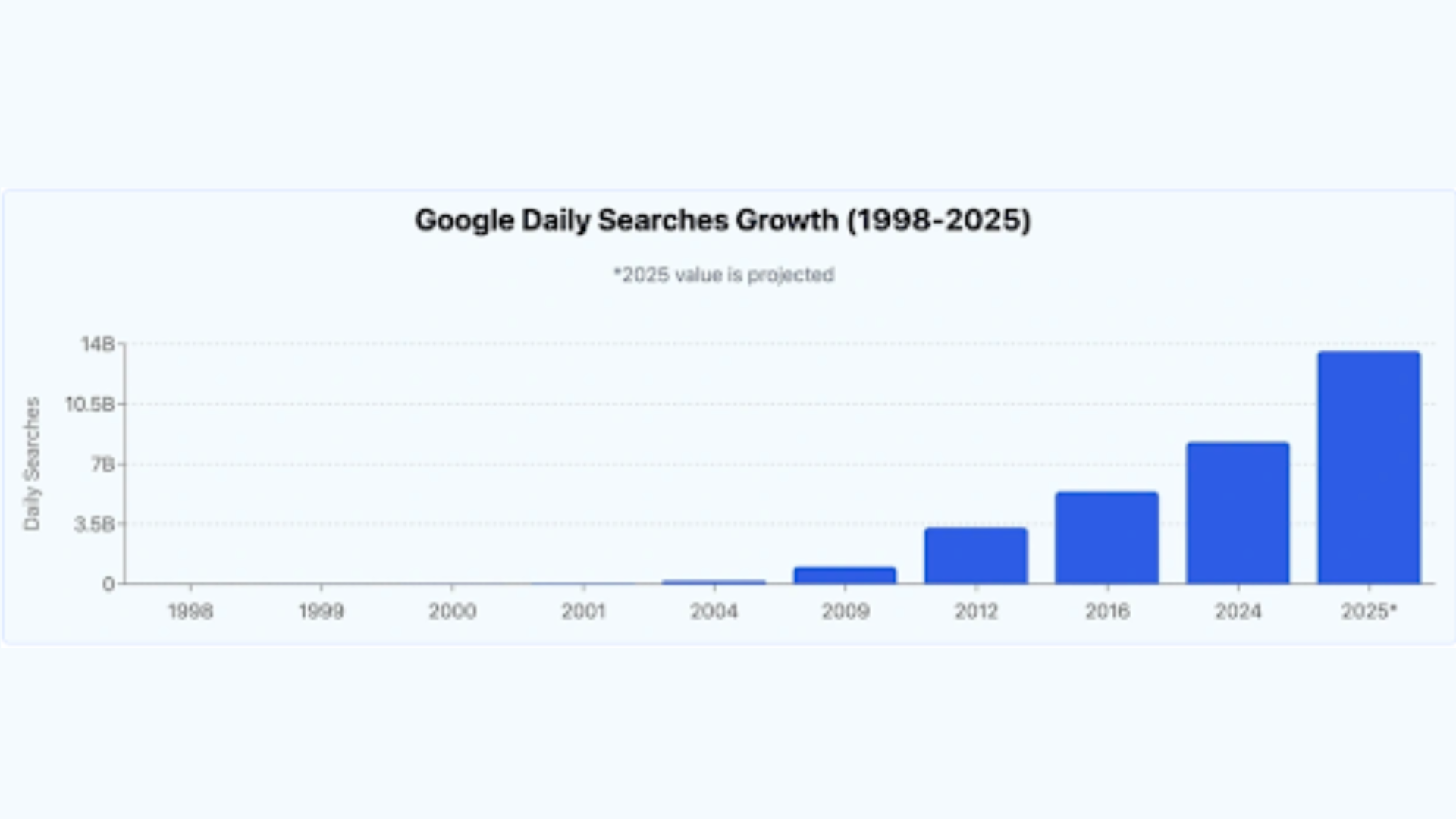
Source: https://explodingtopics.com/blog/google-searches-per-day
To demonstrate how rapidly this is evolving, while while writing this article, it has just been reported that Google is testing a new AI model embedded into its search engine, signalling a "new phase of the AI platform shift".
Sam Page, CEO of 7DOTS says: “Brands that lean into new formats and channels early, test boldly, and adapt fast are the ones that consistently outperform those that wait and get left behind.”
Sam’s advice is:
- Above all else, focus on the end user.
- Consider every step of their journey.
- Keep producing valuable, high-trust content.
- Map to buyer intent.
- Embrace the change.
Work with a trusted partner to help navigate changes
Michael Curtis, Head of SEO at 7DOTS reassures us that this isn’t the time to panic. It’s imperative to gain strategic clarity to make informed decisions based on actual data and trusted expertise.
The real question, therefore, isn’t whether we should be worried but rather: how do you create the right content for optimal engagement and enhanced user experiences?
“If there’s one lesson any business that wants to be durable should learn, it’s the value of ultimately owning the customer relationship… Companies should be constantly mindful about how they lock in a relationship with a customer.” — Mike Curtis, 7DOTS Head of SEO.
2. Framing AI and the different use cases
“The question brands need to be asking is how they leverage AI agents as a first touch, and how do they then develop direct customer experiences following that touch point.” — Mike Curtis, 7DOTS Head of SEO.
Mike suggests that AI user behaviour can be classified in one of three ways:
Ai use cases
AI the agent
“Agentic AI is the idea that AI can work out, on its own, how to perform tasks end to end. When people talk about mass reductions of human capital and the need to radically restructure entire economies around AI, this is what they’re thinking of. You task an agent to do something, and it works out not just how to do the specific instructions, but what each of those steps should be."
AI the interface
"This is where people are using AI to perform a computing task that isn’t necessarily something new but would have been time consuming or prohibitively complex. For example: ‘Write an Excel formula that does X’, or ‘summarise this email into 3 bullet points.’ Tasks that used to take hours now take minutes and a prompt.”
AI the Search Engine
"This is where people are speculating if this will replace traditional search engines. For example: “I want to know something, so I now ask ChatGPT instead of Google."
Sam Page, CEO of 7DOTS says, Google rolling out AI Overview in the US is “a turning point.
Right now, LLMs are still learning from trusted sources. That means:
- Audience understanding - the number one thing.
- Think user questions, needs and motivations.
- Useful and engaging content.
- Human language.
- Technical structure and accessibility.
If you get this right, you'll end up in the model. If you don't, you'll be left out.”
3. The interface shift: from search to suggest
“Traditional computing is deterministic and binary, the user either pushes the button to trigger the function, or they don’t. LLMs, and the underlying technology of the transformer is probabilistic, matching intent to action.” — Mike Curtis, 7DOTS Head of SEO.
The difference from search to suggest:
- Traditional search is deterministic, based on rules, rankings, and keywords.
- Generative AI is probabilistic, responding to user prompts with the most statistically likely answer.
This can change expectations and experiences:
- People expect instant answers, not documents they have to sift through.
- AI agents may become the first touchpoint in the customer’s journey.
- Brands will have to consider how they design for visibility beyond a URL.
4. The SEO vs GEO dilemma and opportunity
Mike Curtis conducted a comprehensive review of available data and concluded:
- SEO is still 310x more valuable than GEO in the current landscape.
- 68% of online journeys still begin with a search engine (Ahrefs).
- LLMs only serve ‘search results’ in 46% of those searches, meaning they are creating an answer themselves without any meaningful citation 53% of the time.
“OpenAI currently reports about 500m Weekly Active Users. SEMrush recently conducted a study based on the clickstream data of 80m ChatGPT queries, attempting to categorise them based on traditional search categories. They concluded that 70% of the queries do not map onto traditional search usage, these are your ‘summarise this email, make me a Ghibli cartoon, tell me I’m pretty’ type queries…
Search intent on Chat GPT
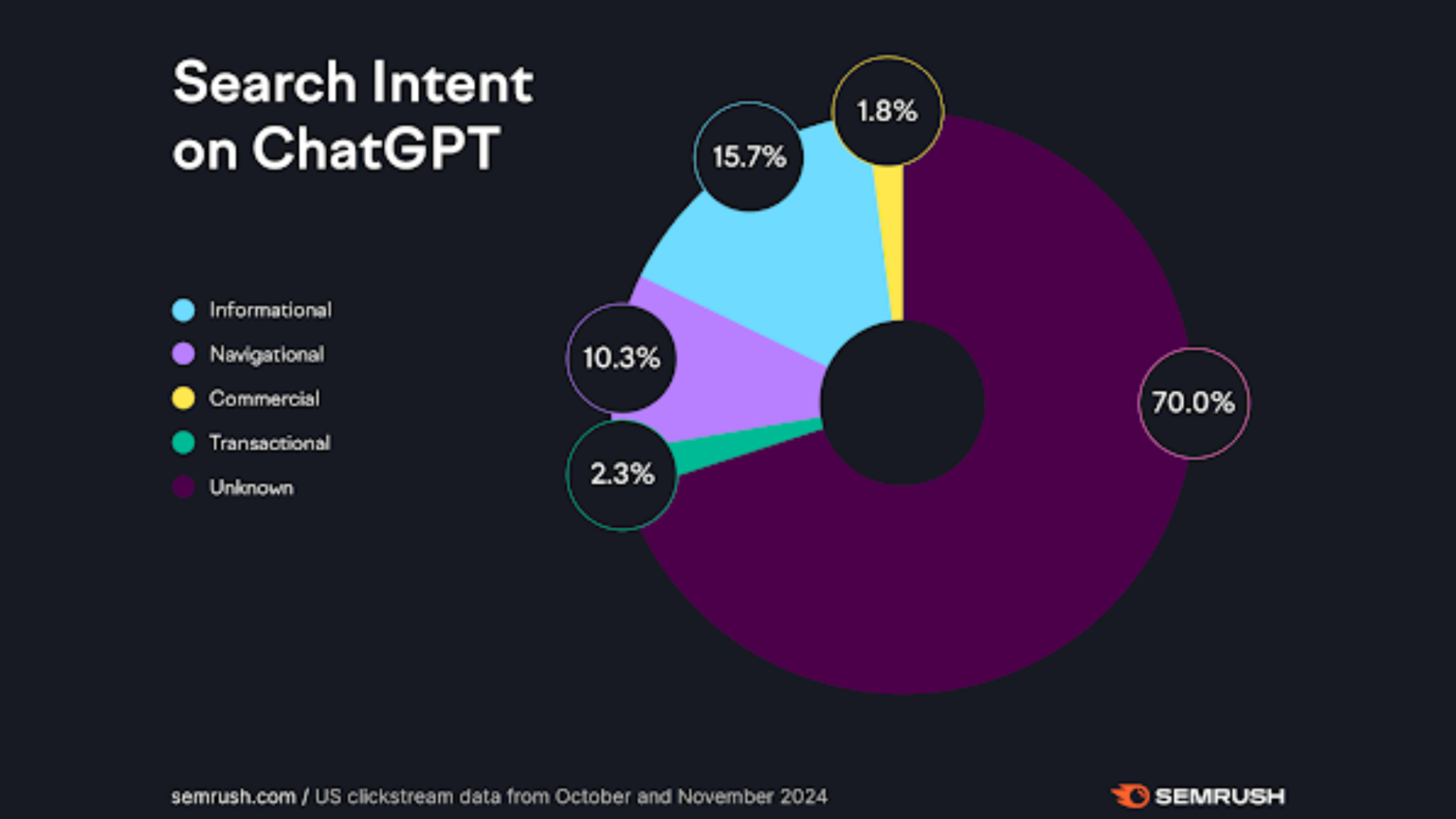
That means there are ~600m ‘users’ using ChatGPT as a search engine per month (Monthly Active Users MAU). The rest are the tools/agentic queries that are not meaningfully comparable.
Google, by comparison, has 85.5bn MAUs. That means that even under the most generous assumptions, the opportunity looks like this:
SEO GEO chart
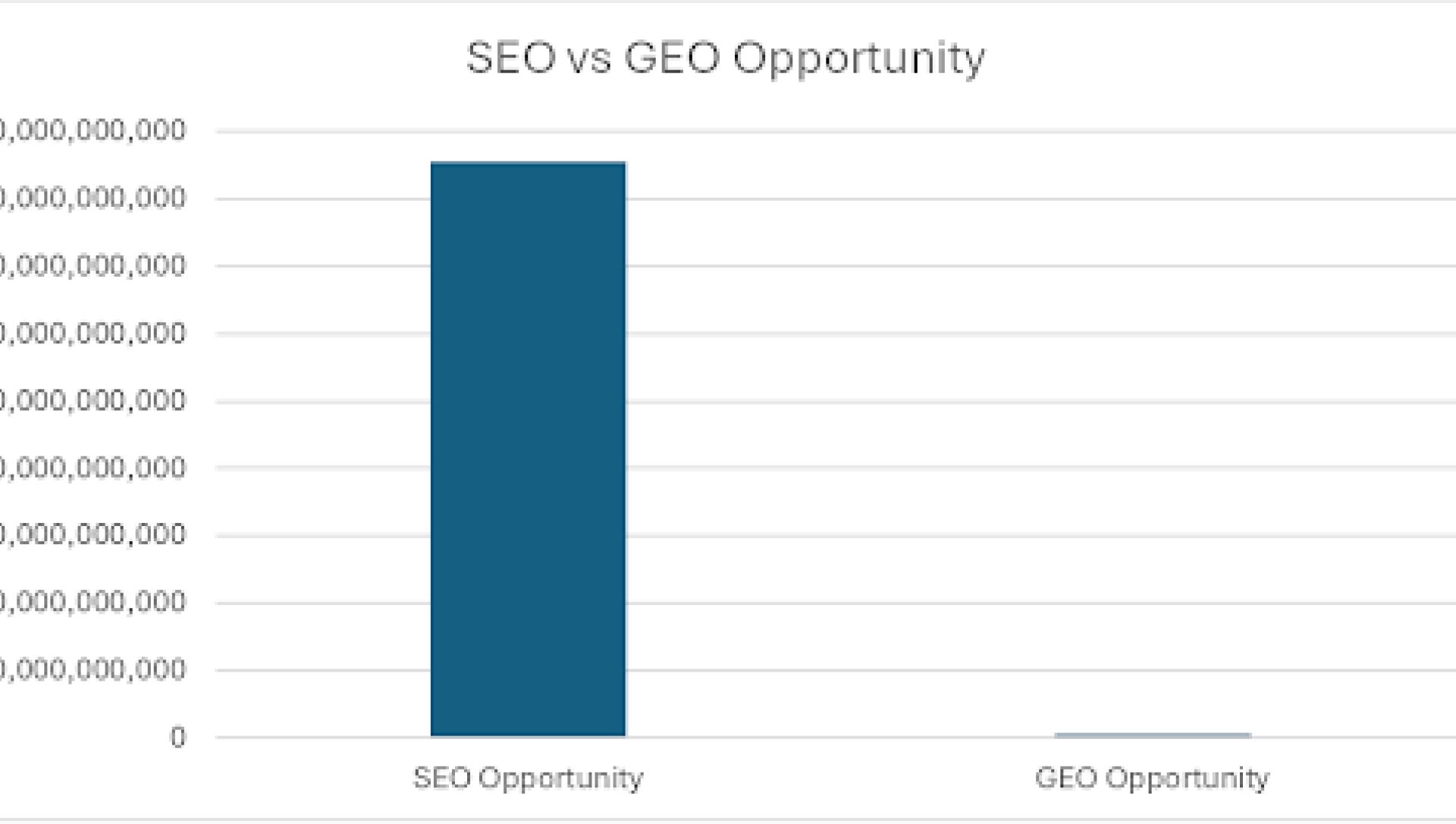
LLMs only serve ‘search results’ in 46% of those searches, meaning they are creating an answer themselves without any meaningful citation 53% of the time. So, the total opportunity in OpenAI actually represents less than half of that in the graph above.
As we have no idea how many users are using ChatGPT directly (represented in SEMRush’s data) and how many are using the API (included in the topline figures from OpenAI). So, the ratio of searches vs tool/agentic queries is probably even less generous than this data suggests. Those API-based queries are almost certainly all either RAG pipeline queries or some form of tooling built on OpenAI’s capabilities.
[Therefore], with the data we’ve got, traditional SEO represents at least 310x the opportunity in GEO right now in 2025. That’s being generous to GEO.
There is one type of AI that is having a real impact in the here and now, the AI generated results in Google.
How does that affect SEO strategy?
This could mean that mid-funnel informational content strategies values are depressed. The return on investment on writing blog posts and evergreen thought leadership for search is reduced. That puts a greater degree of importance on aggressively maximising the opportunity at the bottom of the funnel and building the link and brand signals at the top that will drive visibility at the bottom.
But in lieu of a traffic curve that directly correlates the volume of content published, the importance of being thoughtful and deliberate about how paid and earned channels connect with owned becomes ever greater in a world where each eyeball is so much more difficult to earn.
Ultimately, I think how those dots connect is the real challenge for organisations who want to succeed in the AI age.”
5. What is RAG and why it matters
“I think RAG is one of the most exciting components of AI. We know that historically as much as 95%* of searches are ‘long tail’ (*Source: Ahrefs). AI enables answers not documents. Strategically, it also means companies can keep control of their data, and their content, and deploy both on their own terms. Why is that important? Because, as with agentic AI, the economics around content on the web are liable to disruption, albeit in a way that makes no commercial sense.” — Mike Curtis, 7DOTS Head of SEO.
In a world where AI answers are replacing URLs, Retrieval-Augmented Generation (RAG) offers a powerful middle ground. It lets you combine generative AI with curated, controlled content sources to ensure reliability and retain ownership.
RAG blends LLMs with curated content databases to produce more accurate, brand-safe answers. RAG isn’t just a tech choice, it’s a creative content strategy. It enables publishers to maintain trust and deploy content on their terms, not the AI's.
RAG
RAG solves two key problems:
- Reliability: Reduces hallucinations from AI.
- Control: Keeps publishers in charge of their knowledge assets.
Brands can use RAG to power:
- Customer service chatbots
- On-site search experiences
- AI tools that cite trusted internal sources
7 actions roadmap visual
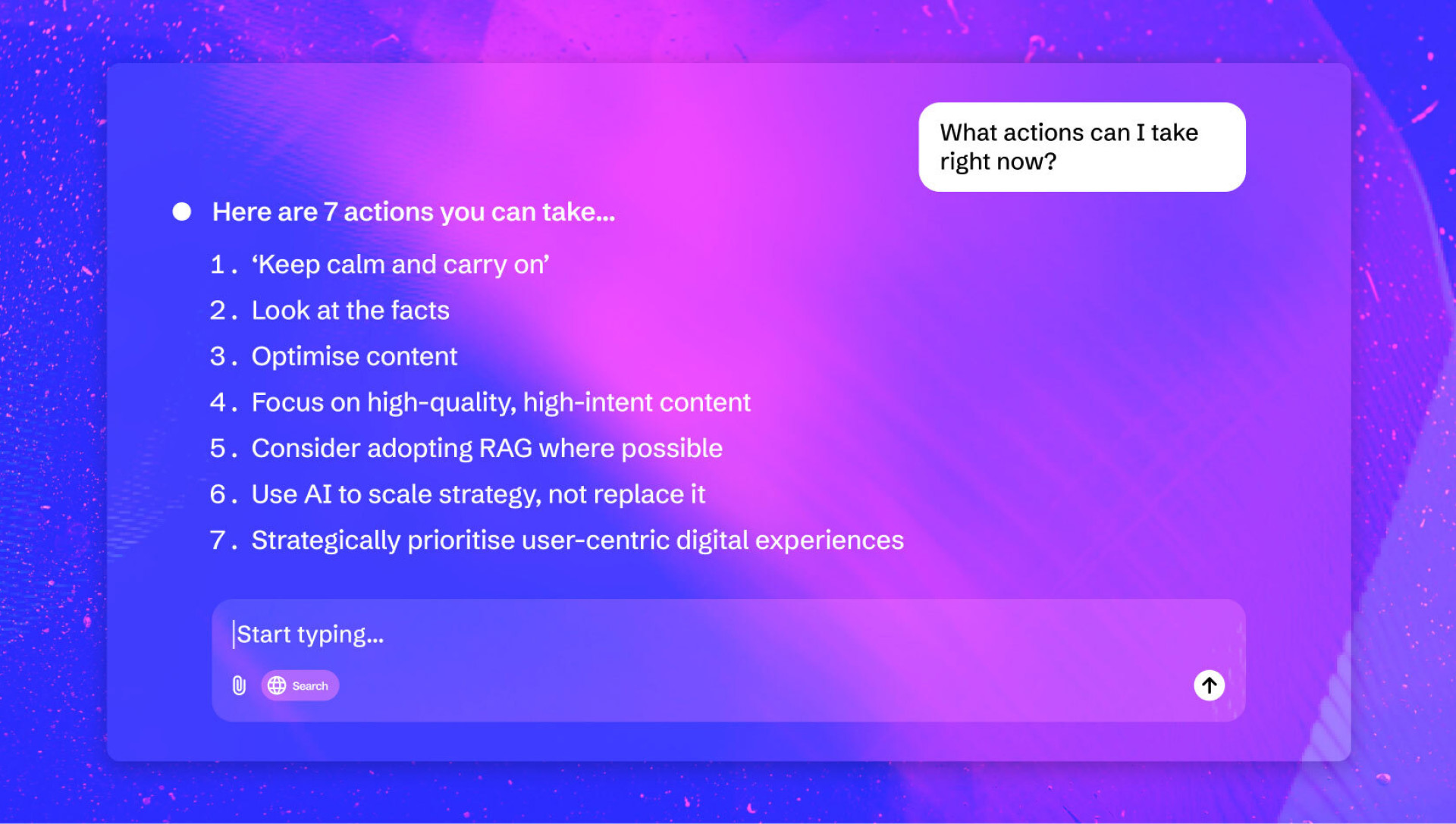
copy
6. Strategic roadmap: 7 actions to take now
✅ 1. ‘Keep calm and carry on... and take action’
There’s a lot of noise out there and as the good old adage says “Keep calm and carry on.” It’s not the time to panic and make reactive uninformed decisions to replace what works with what’s not yet proven or established. However, it is also an opportunity to take action now to optimise for organic, SEO, and AI LLMs.
✅ 2. Look at the facts
Consult the data for clarity to make informed decisions that drive commercial results. It’s important to consult trusted advisors to guide you through a considered response. For example, the 7DOTS Search Landscape Review (SLR) is a data-driven framework that turns search insights into a map of users' needs and wants, to help craft the best user experience.
✅ 3. Optimise content
Don’t abandon SEO. Instead, map content to funnel stages, strengthen branded signals, and build trust signals LLMs can recognise. Structure your site for both LLM visibility and classic search engines. Map to funnel stages and use branded queries.
✅ 4. Focus on high-quality, high-intent content
Mass-produced content no longer cuts it. Focus on intent, trust signals, and value. HubSpot reports 72% of marketers are pivoting to quality-first content strategies in response to AI. Focus on bottom funnel content that converts through commercial opportunities.
✅ 5. Consider adopting RAG
Retrieval-Augmented Generation can deliver authoritative AI answers to drive engagement on your terms. Use RAG to train internal AI tools and build answer engines that reference your own trusted content.
✅ 6. Use AI to scale strategy, not replace it
Let AI improve efficiency, not dictate direction. Use it to automate, analyse, and adapt, while human leaders steer brand narrative. While AI can help handle volume, workflow, and insights, you also need human judgment, strategy, and insights to direct the technology tools.
✅ 7. Strategically prioritise user-centric digital experiences
From information overload to the experience age, users now want to get access to what they want and need as quickly and efficiently as possible. In the experience age, brands need to create compelling experiences if they are going to survive.
The 7DOTS solution below shows you how.
7. 7DOTS solution: user-centric digital experiences
“We’re in the experience age and people are looking for more than a product or service from a brand. They're looking for an experience. That is why we believe that the brands that create the best experiences are the ones that attract, convert and retain more.” — Sam Page, CEO and CO-Founder, 7DOTS.
7DOTS experience age slide
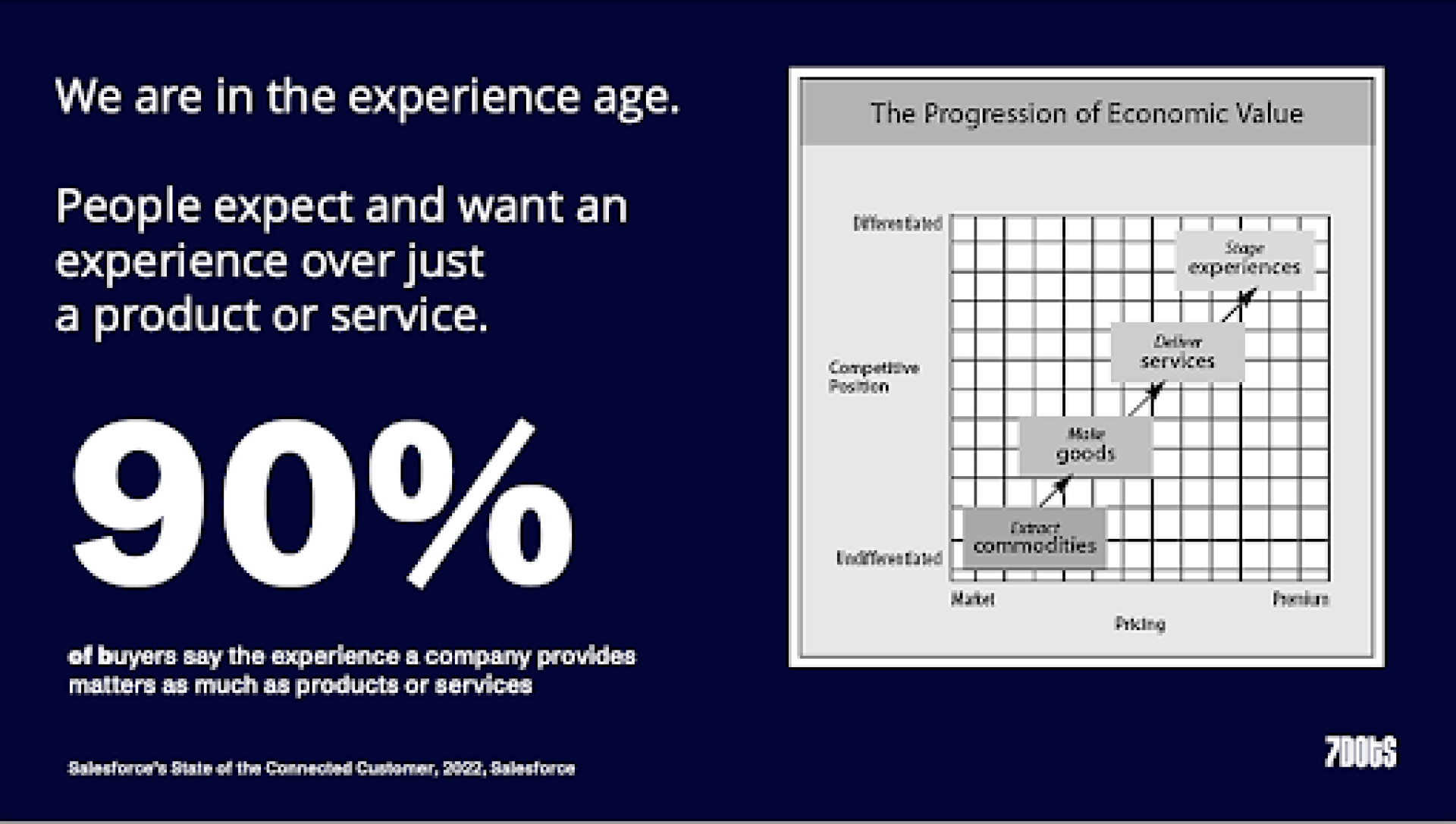
The key to success is to integrate both human-centric and data driven insights, considering qualitative and quantitative from across the board range of tools, expertise, and systems available.
Zoom in and Zoom out - looking at the big picture as well as the finer details.
The 7DOTS Search Landscape Review (SLR) is a data-driven framework that turns search insights into a map of users' needs and wants, to help craft the best user experience.
By fully understanding ‘moments of need’ you can use intelligence from search to stories to create actionable insights.
- Moments of need: by analysing what customers are searching for and which content resonates, you can better understand their true questions, pain points, and motivations.
- From search to stories: The SLR framework uncovers insights and the AI tool can then transform these into user stories that highlight core needs and barriers that need to be overcome.
- Actionable insights for SEO, UX, and CRO:
- SEO: Targets high-intent keywords and user queries.
- UX: Shapes intuitive journeys that speak directly to real iser challenges.
- CRO: Aligns conversion paths with the user’s core motivations and desired outcomes.
By connecting each ‘moment of need’ to an actionable user story, we can deliver digital experiences that genuinely solve problems — boosting reach, engagement and conversions.
7DOTS solution slide SEO CRO UX
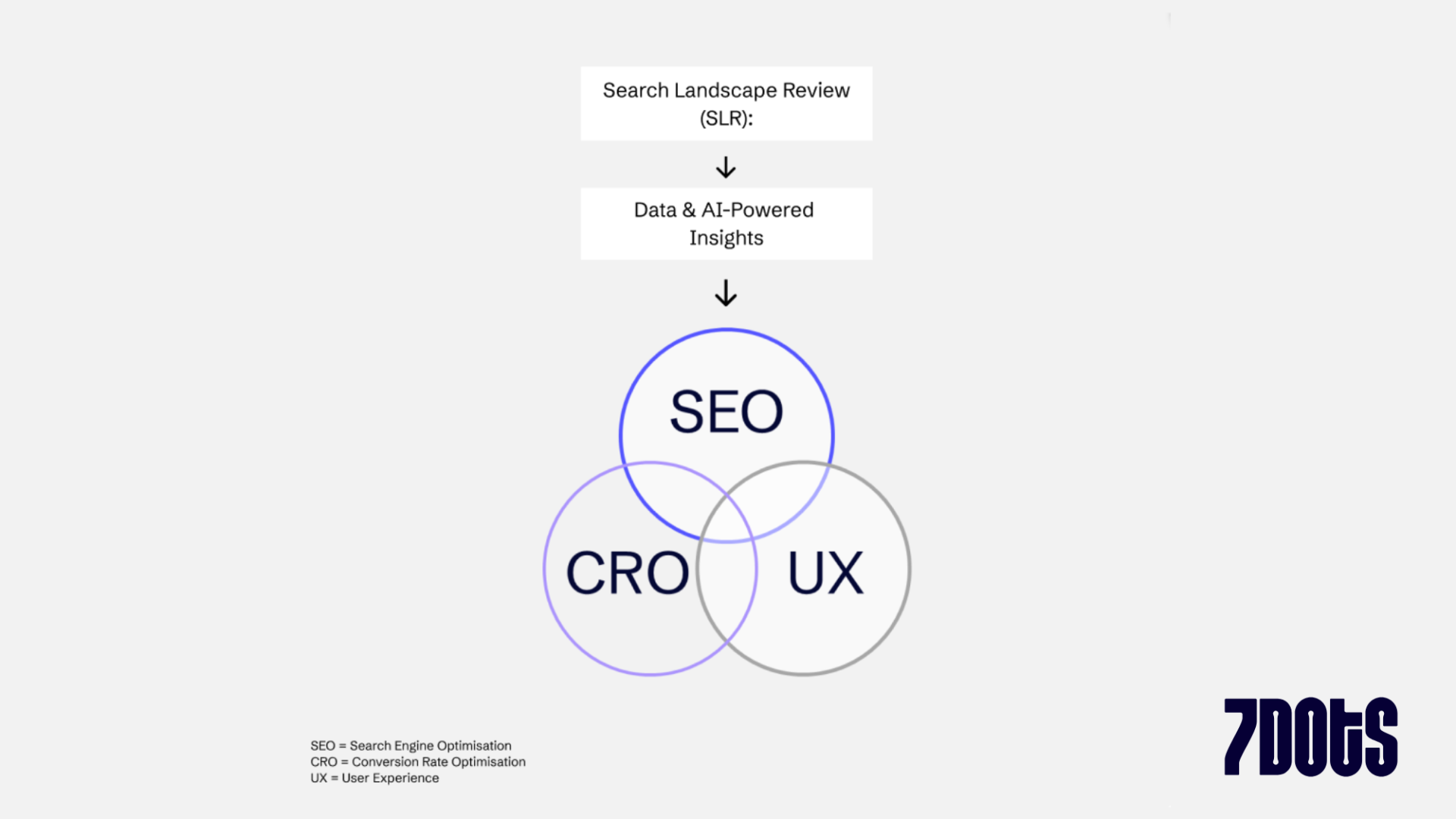
copy 2
7DOTS 4-step process:
1. Insights — blend real world behavioural research with quantifiable data.
2. Strategy — understanding the user journey to deliver what people want/need.
3. Implement — content requirements and architecture to add value at each step.
4. Measure and adjust — continual loop hypothesising, analysing, and optimising.
Next Steps
If you’re ready to turn insight into impact and future-proof your strategy, now is the time to align SEO, AI, and user experience design in one cohesive plan.
Know your customer. Control your content. Prepare for a future where your brand must resonate relevance in the right ways, not just to humans, but also to the machines mediating the web.
Generative AI is reshaping how people find, engage with, and trust content. But SEO isn’t dead and AI isn’t a magic wand. It’s a strategic inflection point.
“You can’t just blindly throw words at a site to get a growth curve anymore. The importance of being thoughtful and deliberate is greater than ever.” — Mike Curtis, 7DOTS Head of SEO.
So instead of asking if you should be worried, the question is:
Are you proactively adapting and creating content and digital experiences that help your business thrive?
The solution involves a strategic shift:
- Optimise for generative AI and use it to fuel efficiency: Build trust, authority, and clarity into every piece of content. From content workflows to predictive performance insights, let AI work for your teams.
- Build adaptability into strategy: Make room for experimentation, innovation, and iteration. What works today may not tomorrow. Be agile and open to adapt and evolve.
- Partner with experts: Partnering with a digital agency that lives and breathes emerging technology can give you a critical advantage. Give your business the best changes of success by choosing partners who can support your journey every step of the way.
copy 3
Stakeholder summary checklist:
For CMOs
- Focus on user experience: Craft experiences for optimal engagement. Brands that create the best experiences attract, convert, and retain more customers.
- SEO is still important: SEO is still significantly more valuable than Generative Engine Optimization (GEO). 68% of online journeys still begin with a search engine.
- Priorise high-quality content: Focus on high-intent, quality content. Mass-produced content is no longer effective.
- Consider RAG: Leverage Retrieval-Augmented Generation (RAG) to deliver authoritative AI answers and maintain control over content.
- Embrace Adaptability: Build adaptability into your strategy. Be agile and open to adapting and evolving your strategies.
For CTOs and COOs
- Understand AI user behaviours: Comprehend the different AI user behaviours: AI as an agent, AI as an interface, and AI as a search engine.
- Implement RAG: Explore RAG to combine generative AI with curated content sources for reliable and brand-safe answers. RAG blends LLMs with curated content databases to produce more accurate answers.
- Technical SEO: Structure your site for both LLM visibility and classic search engines.
- Data-driven insights: Use data-driven insights and intelligence to inform strategy.
- Evaluate AI tools: Assess and integrate appropriate AI tools to enhance search capabilities.
For Procurement
- Forge strategic partnerships: Consider partnering with digital agencies that specialise in innovation and emerging technologies.
- Invest in content strategy: Invest in the creation of high-quality, high-intent content.
- Evaluate RAG solutions: Evaluate RAG solutions for customer service chatbots, on-site search, and AI tools.
- Focus on value exchange: Emphasise the value exchange in AI-generated answers, including attribution.
- Assess Long-Term ROI: Consider the long-term Return On Investment when procuring new search technologies.
Conclusion
Ultimately, the new imperative is to build better experiences.
Brands are increasingly defined by their digital experience and the very best are perceived to be in a category of one.
7DOTS is a digital innovation agency combining strategy technology and creativity to craft extraordinary digital experiences that help businesses grow and thrive.
We help you get the most out of available and emerging technology to innovate next generation solutions, create extraordinary digital experiences and build greater value.
If you are ready to turn insight into impact, outperform the competition, and move into a category of one, let’s connect…
References:
- Gartner (2023): [Future of Search and AI Agents Report]
- Ahrefs (2025): SEO and Generative Engine Statistics
- Statcounter (Q1 2025): Google SGE Adoption
- HubSpot (2024): The State of AI in Marketing
- Exploding Topics (2025): How Many Google Searches Are There Per Day? (March 2025)
